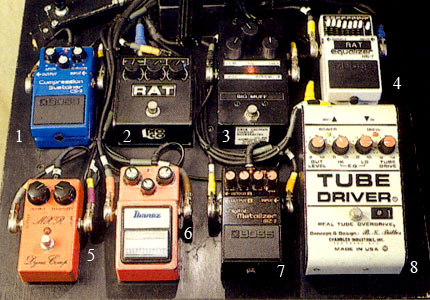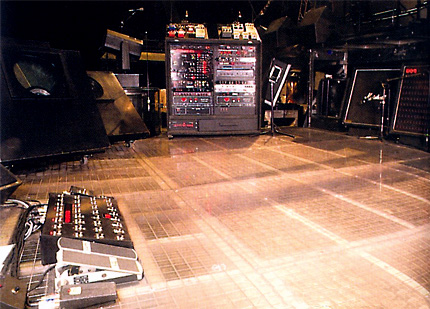David Gilmore
Live at pompeii 1971

- 1. Vox wah wah, 2. Fuzz Face, 3. DeArmond volume pedal, 4. switch for Binson delay.
Animals 1977

1. Vox wah wah, 2. Fuzz Face, 3. DeArmond volume pedal, 4. switch for Binson delay.
Pete Cornish custom pedal board and additional effects, tour 1977
- This is an updated version of the studio board.
Effects listed as in chain.
Dallas Arbiter Fuzz Face (BC109)
Pete Cornish Custom Fuzz P-1
MXR Phase 100
Univox Uni-Vibe
Colorsound Power Boost
Cry Baby wah wah
MXR Dynacomp
(send/return for EH Big Muff and EH Electric Mistress)
Pete Cornish Tone pedal
Pete Cornish volume pedal
(send/return for delays)
MXR Noise Gate/Line Driver
- added prior to the tour, lying ontop of the board, connected via send/return;
Electro Harmonix Big Muff (1973 “Ram’s Head”)
Electro Harmonix Electric Mistress
Binson Echorec II
MXR Digital Delay System I
Morley EVO-1 Echo Volume
Conn Strobo tuners
The Wall 1979-81

Pete Cornish custom pedal board and additional effects, tour 1980-81
- This board is dated January 1976. Effects listed as in chain.
Dallas Arbiter Fuzz Face (BC109)
Electro Harmonix Big Muff (1973 “Ram’s Head”)
MXR Phase 90
Electro Harmonix Small Stone
Electro Harmonix Electric Mistress
Pete Cornish (ST-2) Treble and Bass Boost
Cry Baby wah wah
MXR Dynacomp
Pete Cornish Tone pedal
Pete Cornish volume pedal
(send/return for delays)
MXR Noise Gate/Line Driver
MXR Digital Delay System I
Boss CE-2 Chorus (added via send/return in ‘80)
Conn Strobo tuners
Note: The board had two inputs with a selector witch, a tuner feed (Conn Strobo Tuner) and three outputs for each amp with individual selector switches.
There were two Boss CE-2 chorus pedals lying next to the board. These might have been used to create a stereo effect with one pedal assigned to each Hiwatt.
About face 1984

1. 2 MXR Digital Delay System II
2. 2 MXR Digital Delay
3. 2 Conn ST-11 Strobo Tuners
4. 3 Fender Twin Reverb II heads
5. Mesa/Boogie amp
6. Gallien-Krueger 250 ML MK II
7. Schaffer Vega wireless system
8. Boss SCC-700 board,
(from top left) SD-1 overdrive, GE-6 equalizer, CE-3 chorus, CS-2 compressor, HM-2 distortion, DD-2 digital delay, DD-2 digital delay
(right side) CE-3 chorus, GE-7 equalizer
The Division Bell

1. Boss CS-2 compressor
2. ProCo RAT II
3. Pete Cornish P-2 (labeled “Big Muff”)
4. Boss GE-7 graphic EQ (for RAT)
5. MXR Dynacomp (script logo)
6. Ibanez CP-9 compressor
7. Boss MZ-2 Digital Metalizer
8. Chandler Tube Driver

1. Pete Cornish Soft Sustain
2. Sovtek Big Muff (”Civil War”)
3. Chandler Tube Driver
4. Boss GE-7 graphic EQ (treble & bass boost)
5. Boss GE-7 graphic EQ (bass boost)
6. Boss GE-7 graphic EQ (mid boost)

rack 1 (right) - pictured above
1. Furman PL-8 power conditioner and light controller
- used only for lighting the rack
2. TC Electronics TC-2290 Digital Delay
- main delay unit
3. Uni-Vibe (modified for rack)
4. DigiTech ISP-33B Super Harmony pitch shifter
- controlled with a customized Ernie Ball pedal
5. Lexicon PCM-70 digital effects processor
- multi tap delay for Binson effects
6. MXR Digital Delay System II
(ventilation grill)
7. Phil Taylor rack unit with customized effects (left to right)
- Electro Harmonix Electric Mistress
- Boss CE2 chorus (labeled mono chorus)
- Demeter Tremulator tremolo
- Boss CE2 chorus (labeled left chorus)
8. Dynacord CLS-222 Leslie simulator
(ventilation grill)
9. Samson UR-5 UHF Dual wireless reciever
10. Peterson R450 Strobe tuner

- David’s stage setup during the Division Bell tour. Notice the Doppola, Marshall and WEM speakers in the back. In the left lower corner you can just spot the Heil Talk Box, used on Keep Talking.
For more info check out
http://www.gilmourish.com
.

































